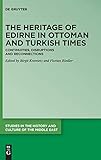The Heritage of Edirne in Ottoman and Turkish Times : Continuities, Disruptions and Reconnections / ed. by Birgit Krawietz, Florian Riedler.
Material type: TextSeries: Studies in the History and Culture of the Middle East ; 34Publisher: Berlin ; Boston : De Gruyter, [2019]Copyright date: ©2020Description: 1 online resource (XVII, 575 p.)Content type:
TextSeries: Studies in the History and Culture of the Middle East ; 34Publisher: Berlin ; Boston : De Gruyter, [2019]Copyright date: ©2020Description: 1 online resource (XVII, 575 p.)Content type: - 9783110634136
- 9783110635157
- 9783110639087
- 949.61 23
- DR741.E4 H47 2020
- online - DeGruyter
- Issued also in print.
| Item type | Current library | Call number | URL | Status | Notes | Barcode | |
|---|---|---|---|---|---|---|---|
 eBook
eBook
|
Biblioteca "Angelicum" Pont. Univ. S.Tommaso d'Aquino Nuvola online | online - DeGruyter (Browse shelf(Opens below)) | Online access | Not for loan (Accesso limitato) | Accesso per gli utenti autorizzati / Access for authorized users | (dgr)9783110639087 |
Frontmatter -- Foreword -- Acknowledgements -- Contents -- Approaching Edirne. Dis-/Connections and Attractions -- Part I: Forming Edirne -- In Search of Early Ottoman Edirne -- The Formation of Early Ottoman Urban Space. Edirne as Paradigm -- Connecting Capitals. Edirne Among Early Ottoman Scholarly Destinations -- Part II: Imperial Architecture -- Challenging the Hagia Sophia. The Selimiye Mosque in Edirne as Ottoman Empire Branding -- Edirne as a Stopover Destination. The Ekmekçioğlu Caravanserai and the Ottoman Road Network -- Part III: Heritage Construction in the Turkish National State -- The Resurrection of Edirne’s New Imperial Palace as National Heritage -- Designing Edirne’s Heritage Trail and Turkish Oil Wrestling -- Part IV: Crossroads Edirne -- The Formation of the First Ottoman “Mother of Israel” in Edirne -- The Diplomatic, Religious, and Economic Presence of the Republic of Dubrovnik (Ragusa) in Ottoman Edirne -- Part V: Disrupting and Re-framing -- The Beautiful and the Brutal. Bulgarian Images of Odrin (Edirne) and the Contours of the Ethnonational Mindset -- The Balkan War Martyrdom Memorial and Intersensorial Remembrance in Edirne -- The Anti-Jewish Pogrom in 1934. Problems of Historiography, Terms and Methodology -- Part VI: Re-connecting Edirne -- Building Modern Infrastructures on Ancient Routes. Road and Rail Development in 19th-Century Edirne -- Region versus Metropolis. Thrace and Sprawling Istanbul -- Edirne as a Secondary City. Global Reconfiguration of the Urban -- Outlook -- List of Contributors -- Image Credits -- Index
restricted access online access with authorization star
http://purl.org/coar/access_right/c_16ec
Modern scholarship has not given Edirne the attention it deserves regarding its significance as one of the capitals of the Ottoman Empire. This edited volume offers a reinterpretation of Edirne’s history from Early Ottoman times to recent periods of the Turkish Republic. Presently, disconnections and discontinuities introduced by the transition from empire to nation state still characterize the image of the city and the historiography about it. In contrast, this volume examines how the city engages in the forming, deflecting and creative appropriation of its heritage, a process that has turned Edirne into a UNESCO heritage hotspot. A closer historical analysis demonstrates the dissonances and contradictions that these different interpretations and uses of heritage produce. From the beginning, Edirne was shaped by its connectivity and relationality to other places, above all to Istanbul. This perspective is employed at many different levels, e.g., with regard to its population, institutions, architecture, infrastructures and popular culture, but also regarding the imaginations Edirne triggered. In sum, this multi-disciplinary volume boosts urban history beyond Istanbul and offers new insight into Ottoman and Turkish connectivities from the vantage point of certain key moments of Edirne’s history.
Issued also in print.
Mode of access: Internet via World Wide Web.
In English.
Description based on online resource; title from PDF title page (publisher's Web site, viewed 28. Feb 2023)


